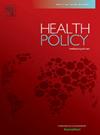慕尼黑病毒:使用差异中的差异来衡量慕尼黑啤酒节对COVID-19感染率的影响
IF 3.4
3区 医学
Q1 HEALTH CARE SCIENCES & SERVICES
引用次数: 0
摘要
2022年德国啤酒节吸引了约600万游客,成为新冠肺炎疫情后规模最大的现场社交活动之一。尽管当时德国的疫苗接种率很高,但卫生当局指出,在这种活动中感染的风险很高。使用一个独特的数据集,我们通过应用事件研究设计来估计慕尼黑啤酒节对感染传播的因果影响。我们的研究结果表明,在啤酒节期间和之后,感染率显著增加,特别是在15-34岁和35-59岁年龄组。然而,在慕尼黑啤酒节之后,发病率下降得相对较快。我们还发现,公平对15岁以下和60岁以上的其余年龄组的感染率几乎没有影响。使用住院率作为因变量的稳健性检查证实了这些结果。我们的研究结果对2019冠状病毒病期间大型社会活动的监管具有重要意义,因为接种疫苗的人在人口中所占比例已经很高。本文章由计算机程序翻译,如有差异,请以英文原文为准。
Munich goes viral: Measuring the impact of the Oktoberfest on COVID-19 infection rates using difference-in-differences
With about 6 million visitors, the 2022 Oktoberfest in Germany has been one of the largest in-person social events following the COVID-19 pandemic. Despite high vaccination rates in Germany at that time, health authorities pointed out the high risk of getting infected at such events. Using a unique dataset, we estimate the causal impact of the Oktoberfest on the spread of infection by applying an event study design. Our results imply a significant increase in the infection rates during and after Oktoberfest, especially in the age cohorts 15–34 and 35–59. However, the case rate drops relatively quickly after Oktoberfest. We also find little to no effect of the fair on the infection rates of the remaining age cohorts below 15 and above 60 years of age. A robustness check using the hospitalization rate as dependent variable confirms those results. Our findings have important implications for regulations of large social events in times of COVID-19, when the share of vaccinated people in the population is already high.
求助全文
通过发布文献求助,成功后即可免费获取论文全文。
去求助
来源期刊

Health Policy
医学-卫生保健
CiteScore
6.40
自引率
6.10%
发文量
157
审稿时长
3-8 weeks
期刊介绍:
Health Policy is intended to be a vehicle for the exploration and discussion of health policy and health system issues and is aimed in particular at enhancing communication between health policy and system researchers, legislators, decision-makers and professionals concerned with developing, implementing, and analysing health policy, health systems and health care reforms, primarily in high-income countries outside the U.S.A.
 求助内容:
求助内容: 应助结果提醒方式:
应助结果提醒方式:


